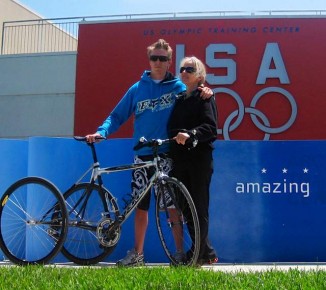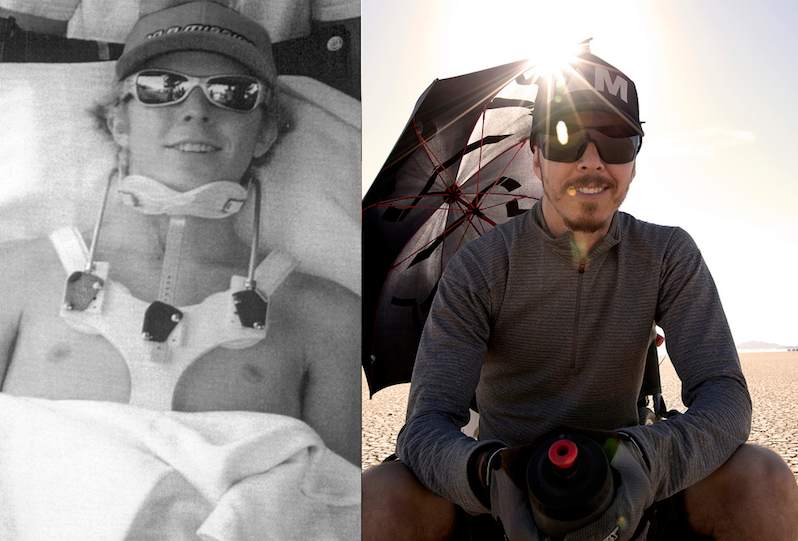Fifteen years after a profoundly life-altering accident, Aaron Baker lives a life that medical professionals never believed possible. A professional motocross racer deemed a complete quadriplegic after a training accident in 1999, Baker is now fully independent, walking with just a cane, and accomplishing feats of endurance, from riding a tandem bicycle across the country, to independently walking 20 miles across Death Valley. Aaron’s drive and commitment to his rehabilitation is inspiring people around the world and proving that the human spirit can be an indomitable force.
At 20 years-old, Aaron’s motorcycle stalled mid-air during a practice run. When it touched down, the wheels locked, sending him over the handlebars in a dive that broke his cervical vertebrae 4-5-6. When Baker woke up from an emergency surgery, he couldn’t feel anything below his neck.
“I couldn’t take a breath on my own,” said Aaron in a video. “All I could do was blink. . . Multiple neurosurgeons gave me a one in a million chance of ever feeding myself again, but this only fueled the fire within me. I thought, who are you to tell me what I can and cannot do?”
Baker’s mother, Laquita Conway, said, “We were told that the maximum amount had been done and that Aaron had recovered as much as possible.” But, she refused to give up hope in a better outcome for her son.
A friend informed her about an exercise physiologist named Taylor-Kevin Isaacs, who was the professor of kinesiology at the Center of Achievement for the Physically Disabled at California State University Northridge. Isaacs had been a professional soccer player who shattered his ankle during a match. In fighting his way back to recovery, he discovered his true passion — physical therapy.
A strong believer that exercise is medicine, Isaacs designed an exercise and nutrition regimen for Baker and after 12 weeks, his flexibility had improved dramatically, allowing him to move in a more normal range of motion.
Baker’s mobility significantly improved month after month, year after year. While training with Isaacs, Baker went from being tied to a walker, to relying on arm crutches, to using a basic four point cane. Eventually, he was able to walk independently with a single point cane for support. Also noteworthy for Baker’s mother: he regained the ability to hug.
 By year three, Baker swung his first golf club and rode his first tandem bicycle. In 2007, he and his mother became an unstoppable team, riding a tandem bike across the United States. They rode from San Diego to Florida in 2007 and from San Francisco to Washington, D.C. in 2008. They cycled to raise awareness of the possibilities of recovery, and the necessity for ongoing therapeutic exercise after sustaining a catastrophic injury or illness.
By year three, Baker swung his first golf club and rode his first tandem bicycle. In 2007, he and his mother became an unstoppable team, riding a tandem bike across the United States. They rode from San Diego to Florida in 2007 and from San Francisco to Washington, D.C. in 2008. They cycled to raise awareness of the possibilities of recovery, and the necessity for ongoing therapeutic exercise after sustaining a catastrophic injury or illness.
After the tour, Baker’s competitive spirit was in full swing. He began training for the U.S. Paralympics Cycling Team in 2009, won gold at the National Championships riding a trike bike in 2011, and was selected to be on the national U.S. Paralympic team for the London Olympic Games in 2012. As an ambassador for Red Bull’s Wings for Life foundation, he will be participating in the world run, on May 3, 2015, to raise money to find a cure for spinal cord injuries. Learn more at AaronBakers.com.
Aaron was able to beat his one-in-a-million odds for recovery, and now, along with Isaacs and his mom, he wants to help others move beyond their perceived limitations. The trio opened a state-of-the-art facility in Northridge where other special-need individuals could receive support and have the same opportunity for recovery as he did. The Center of Restorative Exercise (C.O.R.E.), provides customized exercise programs and equipment to those suffering from a spinal cord injury, muscular dystrophy, diabetes, hypertension, osteoporosis, and other disabling conditions.
“Too many people with a disabling condition accept their grim diagnosis and stop pushing for their health,” explained Issacs. “We strongly believe in the restorative and preventive properties of exercise. While physical inactivity can cause the body to break down and degenerate, an active lifestyle can energize, maintain, and return function to the body.”
(WATCH the video about Aaron Baker below)
SHARE the Inspiration with the Buttons below…




















